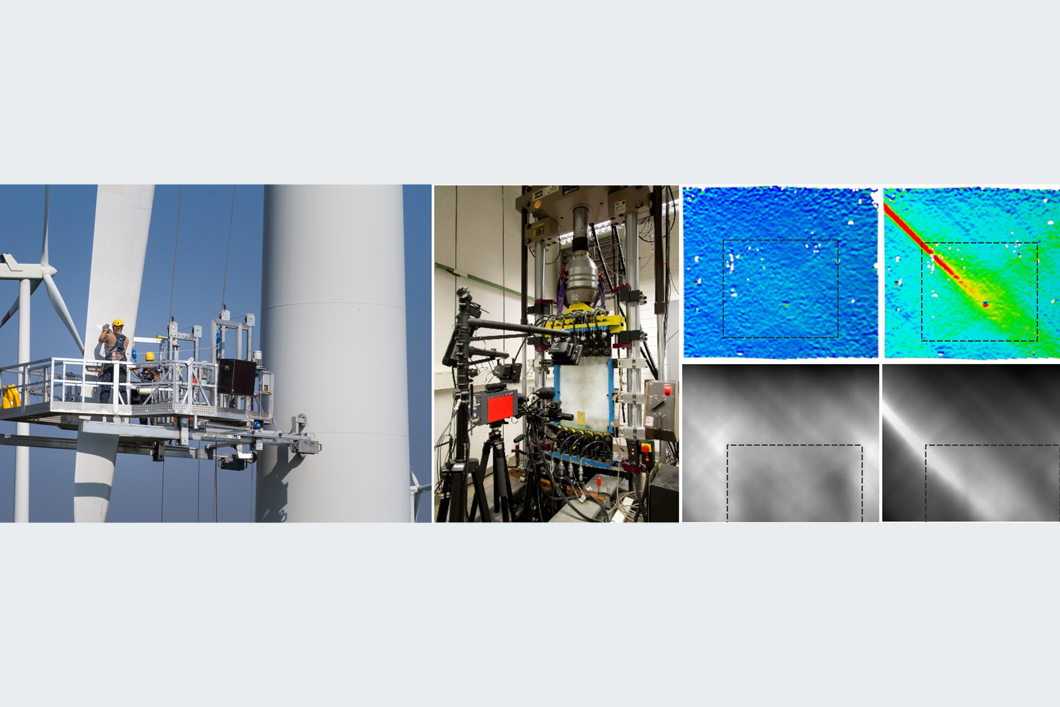
Left to right: A repaired of a rotor blade; shell test bench with specimen; repair area on a sandwich shell specimen at the beginning and end of a fatigue test (top images show deformation in the form of longitudinal strain, bottom images show thermograms).
Source: Henning Markötter, Kang Dong.
Wind turbine rotor blades are produced as aerodynamic, three-dimensionally formed sandwich shell structures using lightweight fiber reinforced polymers (FRP). The FRP used today have the potential to withstand the harsh operating conditions of rotor blades over the projected service life of 20 years. Premature damages that occur can be traced primarily back to design and/or manufacturing imperfections, as well as unusually high load scenarios (for instance lightning strikes, or strong winds combined with system control errors). Rotor blades have to therefore be repaired several times (on average 2-3 times) during their projected service life. Approximately 70% of these are repairs of small- to medium-sized sandwich shells, carried out by technicians directly accessing the blade by suspended roping at the wind turbine location. The goal is to execute repairs that will last over the remaining service life, i.e. be sustainable.
A simple and commonly used technique is to locally repair the damaged blade areas using a patch-style bond, where reinforcing FRP layers are adhesively bonded to the damaged area. This method can, however, lead to local stiffness peaks at the edges of the repair area, which in turn can lead to new damages. It is therefore better to use a scarf repair technique with a scarf ratio of 1:50, where for instance a 2 mm thick FRP laminate is sanded with angled walls to prepare a 100 mm repair area upon which new FRP layers are applied and the surface profile is restored. This leads to an optimized repair in terms of aerodynamics as well as structural mechanics. This method is well established in the field of aerospace and general aviation repairs. Within the framework of the research project carried out at BAM by Dr. C. Ghafafian and Prof. V. Trappe, division 5.3 Polymer Matrix Composites, department 5 for Materials Engineering, not only was the geometric shape (round vs. square in relation to the top view) varied, but also the layup of the scarf repair structure, variables that have not been studied systematically to-date. Sub-component scale sandwich shell specimens with representative repairs were used in this work in addition to coupon-scale specimens that are more commonly seen in literature. These sub-component shell specimens were tested using a unique shell test bench under loading conditions representative of wind turbine blade shell operating conditions with respect to fatigue strength. Using non-destructive testing methods (field strain measurement and thermography), damage development and distribution was monitored and analyzed in-situ. As a result, a concept could be developed in which the repaired areas showed at least equivalent if not higher fatigue strength than the reference shells that were not repaired.
Prolonging structural integrity—Fatigue of scarf repairs for wind turbine blade shell applications
Carineh Ghafafian, Volker Trappe
published in Composites Part A, Volume 167, Article number 107419, 2023.
BAM Department Materials Engineering
BAM Division Polymer Matrix Composites


